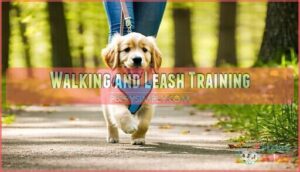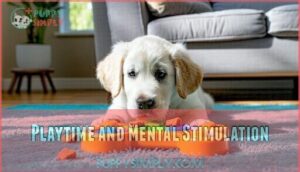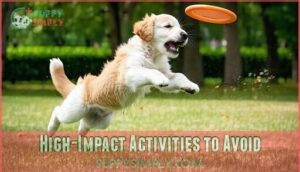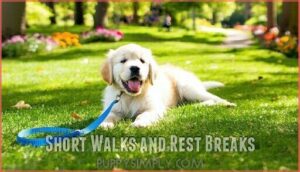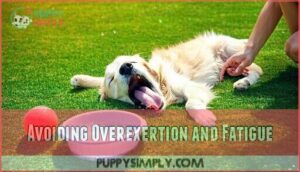This site is supported by our readers. We may earn a commission, at no cost to you, if you purchase through links.
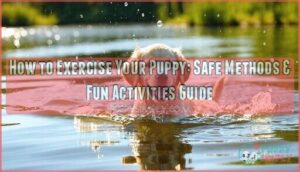 Knowing how to exercise your puppy safely protects their growing joints while burning off that puppy energy.
Knowing how to exercise your puppy safely protects their growing joints while burning off that puppy energy.
Start with short 5-minute walks per month of age, twice daily.
Skip high-impact activities like jogging or jumping until they’re fully grown.
Instead, focus on gentle play sessions, basic training, and mental stimulation through puzzle toys.
Think of it like building a foundation – you wouldn’t rush construction on a house.
Watch for signs of tiredness like excessive panting or lagging behind.
Swimming is excellent low-impact exercise for most breeds.
Remember, a well-exercised puppy is a happy puppy, but overdoing it can cause lasting damage to developing bones and joints.
Table Of Contents
- Key Takeaways
- Puppy Exercise Basics
- How to Exercise Puppy
- Safe Exercise Methods
- Mental Stimulation Techniques
- Exercise Safety Precautions
- Frequently Asked Questions (FAQs)
- What is a good exercise for a puppy?
- Is exercise good for a puppy?
- How can I Keep my Puppy safe while exercising?
- How do I get my Dog to exercise a lot?
- How do you train a puppy?
- How much exercise does a puppy need?
- What is the best way to exercise a puppy?
- What is the 10 minute rule for puppies?
- How do you tire out a puppy?
- What is the 5 minute rule for puppies?
- Conclusion
Key Takeaways
- Start with short, age-appropriate walks – Follow the 5-minute rule (5 minutes per month of age, twice daily) and avoid high-impact activities like jogging or jumping until your puppy is fully grown to protect developing growth plates.
- Watch for signs of overexertion – Stop exercising if you notice excessive panting, limping, reluctance to continue, or lagging behind, as puppies do not always know when to quit and overexercising can cause lasting joint damage.
- Prioritize mental stimulation over physical exhaustion – Use puzzle toys, hide-and-seek games, and basic training sessions to tire out your puppy’s brain, which is often more effective than long walks and safer for developing joints.
- Tailor exercise to your puppy’s breed and development stage – High-energy breeds need more activity than smaller companions, and larger breeds require longer sessions but develop more slowly, so adjust your routine based on your puppy’s specific needs and growth timeline.
Puppy Exercise Basics
Your puppy’s exercise needs depend on their age, breed, and development stage, not just their energy level.
Understanding these basics helps you create a safe routine that protects growing joints while keeping your furry friend healthy and happy.
Age and Development
Your puppy’s exercise needs change dramatically as they grow.
During the first 12-18 months, bone development and growth plate fusion aren’t complete, making high-impact activities risky.
Each developmental stage requires different puppy exercise guidelines.
Young pups need gentle play, while older ones handle more activity.
Exercise progression should match your puppy’s development timeline for ideal puppy joint health, ensuring a safe and healthy growth through gentle play.
Breed and Size Considerations
Different puppy breeds come with unique exercise needs that you’ll want to match carefully.
Sporting breeds like Labradors need more activity than smaller companions like Chihuahuas.
Your puppy’s size affects exercise intensity – larger breeds require longer sessions but develop slower.
Understanding breed predispositions helps you create safe puppy exercise guidelines that support healthy growth rates without overwhelming their developing systems.
For example, sporting breeds often need an hour of daily exercise.
Growth Plates and Joint Health
Understanding your puppy’s growth plates is essential for preventing lifelong joint problems.
Protecting those soft growth plates now means healthy joints for life—it’s worth the extra caution.
These soft cartilage areas at bone ends don’t fully close until 12-24 months, making overexertion risky during this critical puppy bone development period.
One concern is repetitive loading impacts on these areas.
- Joint Development: Growth plate closure varies by breed – larger dogs take up to two years
- Overexertion Risks: High-impact activities can cause permanent damage and early arthritis
- Injury Prevention: Monitor for limping, reluctance to play, or excessive panting during exercise
How to Exercise Puppy
Exercising your puppy requires a careful balance between providing enough activity to keep them healthy and avoiding overexertion that can damage their developing joints.
You’ll need to focus on age-appropriate activities like short walks, supervised play, and mental stimulation while steering clear of high-impact exercises until your puppy reaches full maturity, which involves a careful consideration of their developing joints.
Walking and Leash Training
Most puppies can start puppy walking around 8 weeks old, though some owners wait until 12-16 weeks.
Begin leash training early to prevent leash pulling habits and guarantee control during walks. Start with 15-20 minute sessions twice daily, then gradually increase time to build gradual stamina while allowing safe exploration at your pup’s pace.
Selecting the right puppy walking gear is essential for a safe and enjoyable experience.
| Leash Training Age | Walking Distances | Safe Exploration Tips |
|---|---|---|
| 8-12 weeks: Short sessions | 5 minutes per month of age | Use backpacks or carriers for longer trips |
| 12-16 weeks: Structured walks | Twice daily maximum | Supervise backyard exploration |
| 4-6 months: Building stamina | 25 minutes max for 5-month puppy | Parks and lakes for puppy socialization |
Playtime and Mental Stimulation
Mental stimulation often tires your puppy more effectively than physical exercise.
A tired mind is a happy puppy – mental games beat long walks every time.
Training games and interactive play develop cognitive skills while burning energy.
Puzzle toys and snuffle mats challenge your pup’s brain, preventing boredom and destructive behaviors.
A key element is rewarding calm moments to reinforce relaxation.
- Hide treats around the house for treasure hunts
- Use puzzle feeders during meal times
- Practice basic commands with positive reinforcement
High-Impact Activities to Avoid
Enthusiasm can turn dangerous when puppies tackle high-impact activities.
Avoid jumping, jogging, cycling, and intense ball-chasing that stress developing growth plates.
These activities risk joint health problems like hip dysplasia and early arthritis signs.
Skip stairs, rough terrain, and repetitive fetching until your pup’s fully grown.
Growth plate damage from puppy overexercising isn’t worth the risk.
Safe Exercise Methods
Exercising your puppy safely means starting slow and watching for signs that they’re getting tired.
You’ll need to balance activity with plenty of rest breaks, since puppies can hurt their developing joints if they do too much too soon, which requires balance and rest.
Short Walks and Rest Breaks
When starting your puppy exercise routine, begin with 15-20 minute walks twice daily.
Follow the five-minute rule: five minutes of walking per month of age, twice daily.
Build gradual stamina by increasing walk duration slowly.
Take frequent breaks during walks, using leash control to enforce rest when your puppy shows fatigue.
Short, consistent sessions meet puppy exercise needs safely.
Integrating brief periods of high intensity exercise can also improve fitness.
Supervised Exploration and Play
Beyond scheduled walks, your puppy needs guided exploration to develop confidence and social skills.
Create safe environments where your pup can discover new sights, sounds, and textures under your watchful eye.
- Backyard adventures let puppies explore freely while you maintain control
- Socialization benefits emerge when pups meet new people and friendly dogs
- Interactive games like treasure hunts stimulate natural curiosity
- Toy selection should include varied textures for sensory development
- Puppy supervision guarantees safety during all exploration activities
Avoiding Overexertion and Fatigue
Your puppy won’t always know when to stop, so recognizing fatigue becomes your job.
Watch for excessive panting, reluctance to continue, or limping. Enforced rest protects developing joints from damage.
Breed differences matter – larger dogs need more caution. Keep water handy since hydration importance can’t be overstated.
Remember, puppy overexercising causes lasting harm, so shorter sessions with breaks work best.
Mental Stimulation Techniques
Your puppy’s brain needs exercise just as much as their body does, and mental stimulation can tire them out more effectively than a long walk.
You can challenge your puppy’s mind with simple games and activities that build problem-solving skills while keeping them entertained and focused.
Hide and Seek Games
Hide and seek transforms your living room into an adventure playground for puppy exercise and mental stimulation.
Start with indoor hide-and-seek by having your puppy stay while you hide behind furniture, then call their name.
Add toy hiding challenges by placing favorite items around the house.
Use treat motivation to encourage scent work – hide treats in boxes or under blankets for engaging puppy games.
DIY Agility Courses
Building a DIY agility course for your puppy doesn’t require breaking the bank.
Start with simple obstacles like jump bars and weave poles in your backyard. Course material safety matters—use lightweight materials that won’t harm your pup.
Focus on skill progression by introducing one obstacle at a time. Creative obstacle ideas include tunnels made from cardboard boxes.
This cost-effective agility training builds confidence while providing excellent puppy exercise. You can also focus on Weimaraner agility foundations to enhance your puppy’s skills.
Interactive Toys and Puzzle Feeders
Why settle for boring meals when you can turn feeding time into brain-boosting fun?
Interactive toys and puzzle feeders transform your pup’s daily routine into exciting mental workouts that prevent boredom and support cognitive development.
- Kong toys stuffed with treats challenge problem-solving skills
- Snuffle mats mimic natural foraging behaviors
- Puzzle feeders slow eating while engaging minds
- DIY puzzles using muffin tins create affordable enrichment
Consider Kong toys for puppies to soothe teething discomfort.
Exercise Safety Precautions
You’ll need to watch for signs that your puppy’s getting too much exercise, since overdoing it can damage their growing bones and joints.
Weather conditions, your puppy’s breed, and age all affect how much activity they can safely handle, considering their growing bones and joints.
Signs of Overexercising
While mental games keep your puppy sharp, watching for overexercise warning signs protects their developing body.
Recognizing these red flags prevents long-term joint damage and keeps your furry friend healthy. Sudden behavioral changes can also indicate a problem, so it’s important to watch for signs of a sick dog.
| Physical Signs | Behavioral Changes | Serious Warnings |
|---|---|---|
| Panting Excessively | Refusal to Walk | Joint Pain symptoms |
| Limping gait | Post-Exercise Exhaustion | Excessive fatigue |
| Heavy breathing | Reluctance outdoors | Won’t eat/drink |
| Stumbling steps | Hiding behavior | Trembling muscles |
Weather Considerations and Safety Tips
Weather conditions can make or break your puppy’s exercise routine.
In summer, schedule walks during cooler morning hours and always check pavement temperature—if it’s too hot for your hand, it’ll burn those precious paws.
Pack water for hydration breaks and watch for heatstroke signs.
During cold weather, use protective gear and limit outdoor time to keep your furry friend safe and comfortable.
Consider using paw protection products to help shield your puppy’s sensitive paws, and always prioritize their paw protection and overall comfort.
Tailoring Exercise to Lifestyle and Breed
Your puppy’s exercise needs depend on breed characteristics and your daily routine.
High-energy breeds like Australian Shepherds need more activity than laid-back Bulldogs.
Match their individual needs to your lifestyle – city dwellers might focus on indoor games while rural owners can explore off-leash activities.
Consider breed predispositions when planning exercise variety for ideal lifestyle integration.
Frequently Asked Questions (FAQs)
What is a good exercise for a puppy?
Short walks work best for young pups.
Start with 5 minutes per month of age, twice daily.
Mental games like hide-and-seek or puzzle toys tire them out effectively without straining developing joints.
Is exercise good for a puppy?
Like fuel feeding a growing fire, exercise powers your puppy’s development.
Yes, exercise is excellent for puppies when done properly.
It builds strong muscles, healthy joints, and sharp minds while preventing behavioral problems from boredom.
How can I Keep my Puppy safe while exercising?
Start with short walks after full vaccination,
avoid high-impact activities until 12-18 months.
Watch for excessive panting or limping,
and always let your puppy rest when they show signs of fatigue.
How do I get my Dog to exercise a lot?
Marathon runners don’t sprint from day one—they build endurance gradually.
You’ll need patience with your dog’s exercise routine.
Start with short, frequent sessions, mix mental stimulation with physical activity, and slowly increase intensity as your dog matures.
Slowly increasing intensity is key to a successful exercise routine.
How do you train a puppy?
Puppy training starts with basic commands like "sit" and "stay" using positive reinforcement.
Keep sessions short, reward good behavior with treats, and practice consistency.
Early socialization and patience create well-behaved, confident dogs.
How much exercise does a puppy need?
Your puppy needs about 5 minutes of exercise twice daily per month of age.
A 3-month-old needs 15 minutes twice daily.
Focus on short walks, playtime, and mental stimulation rather than intense activities.
What is the best way to exercise a puppy?
Short walks, mental games, and supervised play work best for young pups.
Focus on brain training with puzzle toys and basic commands rather than intense physical activity until they’re fully grown.
What is the 10 minute rule for puppies?
The 10-minute rule suggests exercising puppies for 10 minutes per month of age, twice daily. However, this guideline lacks scientific backing and doesn’t account for breed differences or individual puppy needs.
How do you tire out a puppy?
Your energetic bundle of fur needs mental stimulation more than physical exhaustion.
Training sessions, puzzle toys, and hide-and-seek games will wear them out faster than long walks while protecting their developing joints.
What is the 5 minute rule for puppies?
The 5-minute rule suggests giving your puppy 5 minutes of exercise per month of age, twice daily.
However, this guideline lacks scientific backing and doesn’t apply universally to all breeds or individual needs.
Conclusion
Building a strong foundation for your puppy’s exercise routine is like tending a growing garden—patience and consistency yield the best results.
Remember that learning how to exercise your puppy safely protects their developing joints while channeling their boundless energy productively.
Start slowly with age-appropriate activities, watch for fatigue signs, and prioritize mental stimulation alongside physical play.
You’re not just exercising a puppy; you’re shaping a healthy, well-adjusted companion for life ahead.
- https://www.pawleaks.com/puppy-socialization-how-to-socialize-your-puppy/
- https://pdsapetstore.org.uk/collections/dog-toys-1
- https://www.theatlantic.com/health/archive/2012/10/what-are-they-feeding-you-50-of-us-cats-and-dogs-are-overweight/263296/
- http://www.dogingtonpost.com/how-to-teach-your-dog-to-play-frisbee/
- http://www.sheknows.com/pets-and-animals/articles/1040515/diy-dog-toys

